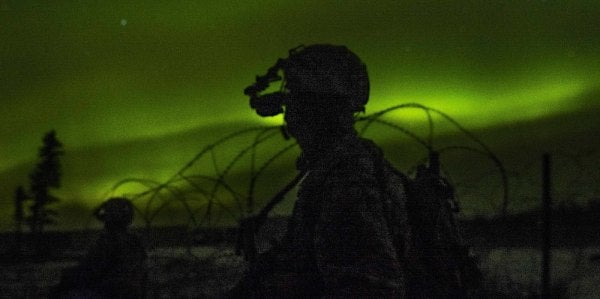Army Scientists Just Unveiled Their Most Advanced Night Vision Tech Yet
The Army just took a major step forward in reclaiming the night: Scientists recently developed a new process to engineer a...

The Army just took a major step forward in reclaiming the night: Scientists recently developed a new process to engineer a material that could revolutionize the branch’s night vision capabilities at minimal cost, the Army announced on Jan. 11. This new material, if incorporated into an infrared camera system, could significantly enhance soldiers’ ability to assess (and lay waste to) the battlefield under the cover of darkness.
“The human eye is optimized by nature to observe reflected light from the sun in a very narrow band of colors (wavelengths of light), known as the visible spectrum,” Army Research Laboratory researcher Dr. Stefan Svensson said in a statement. “However, all objects in nature glow with a faint light even at low temperatures, which produces colors in the infrared (IR) range which are invisible to the naked eye. These wavelengths are about ten times longer than those of visible light.”
The hard science is fascinatingly complicated for laymen (and published in the Journal of Applied Physics, if you’re braver than I am), but here’s what it means for combat troops downrange: You’ll be able to see more detail at longer range even when you’re racing toward a target under pitch black conditions. As ARL’s Dr. Wendy Sarney explained in the Army statement, “The more sensitive such a camera is, or in other words, the smaller the color or temperature differences are that it can see, the more details that can be discerned on a battlefield and enemies can be detected at longer ranges.”
Even better, the new material may appeal to military planners’ pursestrings: Given its prior use in commercially available opto-electronic systems, it represents a significantly cheaper alternative to the compound that the Army’s current IR camera light-sensors rely on — sensors that “are very expensive, mostly because there are only military customers for this material,” as Svensson explained.

Dr. Wendy Sarney uses the molecular beam epitaxy machine at the U.S. Army Research Laboratory to produce infrared detector materials with a new synthesis process.U.S. Army photo
While the Army planned to field 47,000 Enhanced Night Vision Goggle III kits this fall to give soldiers improved visibility in low-light settings and poor weather conditions, the branch is racing against the proliferation of advanced night vision gear among militants; indeed, the erosion of the Army’s night superiority came to a head in November, when a “Red Unit” of Taliban militants outfitted with sophisticated night vision equipment slaughtered scores of Afghan police officers.
Despite the Army’s slipping advantage, the next-generation IR light sensor envisioned by ARL scientists may give soldiers the edge they need to fulfill the branch’s post-Gulf War battle cry — “we own the night” — a reality once more.
WATCH NEXT:
